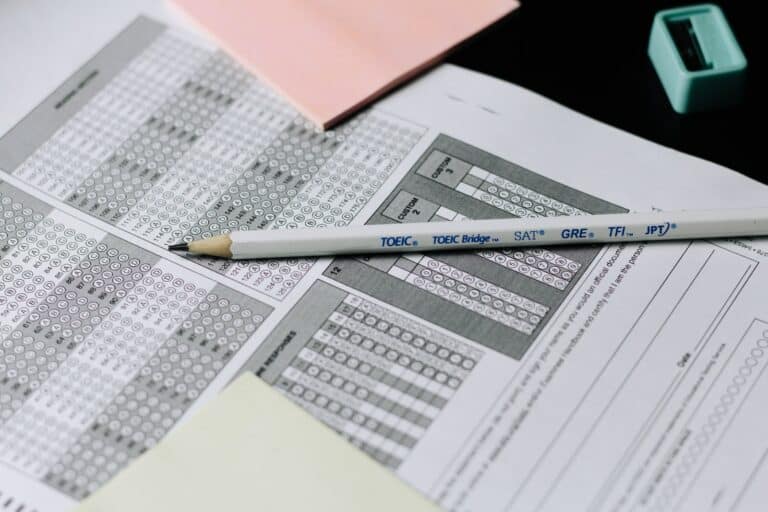Wondering what does the GED test look like? The journey to obtaining a high school equivalency credential often leads individuals to the GED (General Educational Development) test. For those who haven’t completed a traditional high school education, the GED test provides a second chance to showcase their knowledge and skills in key academic subjects. But what does the GED test look like, and how can aspiring test-takers best prepare for this significant milestone?
In this article, we delve into the structure, content, and nuances of the GED test, providing valuable insights into what to expect and how to approach each section. Whether you’re contemplating taking the GED test or seeking guidance for someone on this educational path, understanding its components is crucial for a successful testing experience.
What Does the GED Test Look Like: GED Test Structure and Format
The GED test is comprised of four subject areas: Reasoning Through Language Arts, Mathematical Reasoning, Science, and Social Studies. Each subject area is tested in a separate exam, and all four exams must be passed in order to earn a GED diploma.
The Reasoning Through Language Arts test measures the ability to read, write, and understand text. It includes questions on grammar, sentence structure, and text analysis. The test is divided into two parts: a reading comprehension section and a writing section. The reading comprehension section includes multiple-choice questions based on a reading passage, while the writing section requires the test-taker to write an essay.

The Mathematical Reasoning test measures the ability to reason mathematically, solve problems, and understand mathematical concepts. It includes questions on algebra, geometry, and data analysis. The test is divided into two parts: a calculator section and a non-calculator section.
The Science test measures the ability to understand and analyze scientific concepts and information. It includes questions on biology, chemistry, physics, and earth and space science. The test is divided into multiple-choice and short answer questions.
The Social Studies test measures the ability to understand and analyze social studies concepts and information. It includes questions on history, geography, economics, and government. The test is divided into multiple-choice and short answer questions.
Each of the four GED tests is computer-based and are delivered in a multiple-choice format with the exception of the Reasoning Through Language Arts Writing section. The test is timed and test-takers will have a specific amount of time to complete each test. The total testing time for all four tests is approximately 7 hours and 5 minutes. It is important to note that some states may have slight variations in their testing format, but the overall structure and format remain the same.
GED Test Scoring and Passing Requirements
The GED test is scored on a scale of 100-200, with a passing score of 145 for each subject area. This means that test-takers must score at least 145 on each of the four subject area tests in order to pass the GED and earn a high school equivalency diploma.
Scores are typically released within a few weeks of taking the test, and test-takers will receive a report indicating their scores for each subject area. If a test-taker does not pass a subject area, they can retake the test up to two times within a calendar year.
It’s important to note that each state sets its own passing score for the GED test and some states may have different passing requirements. So, it’s important for test-takers to be aware of the passing requirements in their state before taking the GED test.
Some states may also have additional requirements, such as age limits, residency requirements, and citizenship requirements, so it’s important for test-takers to research and understand these requirements before registering for the GED test.
In summary, the GED test is scored on a scale of 100-200 and test-takers must score at least 145 on each subject area to pass the test. Test-takers are allowed to retake the test up to two times within a calendar year, but it’s important to check the passing requirements in their state before taking the test.
Exploring the GED Test: What to Expect

How Does the GED Test Work?
If you’re contemplating taking the GED exam, understanding how the test is structured is crucial. The GED test comprises four main subjects – Reasoning Through Language Arts, Mathematical Reasoning, Science, and Social Studies. Each subject has its own set of questions, and successfully passing all four subjects is essential to earning your GED diploma.
Unveiling the GED Test Subjects
Reasoning Through Language Arts: Reading and Writing Skills
The first subject, Reasoning Through Language Arts, evaluates your ability to read, write, and comprehend text. It’s divided into two parts – a reading comprehension section with multiple-choice questions and a writing section requiring you to compose an essay.
Mathematical Reasoning: Navigating the World of Numbers
The second subject, Mathematical Reasoning, delves into your mathematical skills, covering algebra, geometry, and data analysis. The test comprises both a calculator and a non-calculator section.
Science: Analyzing Scientific Concepts
Moving on to the Science subject, this section assesses your understanding of biology, chemistry, physics, and earth and space science. Expect a mix of multiple-choice and short answer questions.
Social Studies: Grasping Historical and Social Concepts
The Social Studies subject evaluates your knowledge of history, geography, economics, and government. Similar to the Science test, it includes both multiple-choice and short answer questions.
Understanding GED Test Scoring

The GED test is scored on a scale of 100-200, with a passing score of 145 for each subject area. To earn your GED diploma, you must achieve at least 145 on each of the four subjects. Scores are typically released within a few weeks after the test, and if needed, test-takers can retake a subject up to two times within a calendar year.
Navigating GED Test Prep
How to Prepare for the GED Test
Preparing for the GED test is essential, especially for those who didn’t graduate high school. There are various resources available, including practice tests, study guides, and online services. These tools can help test-takers familiarize themselves with the test format and content areas.
The Role of Practice Tests
Practice tests play a crucial role in GED test preparation. They allow test-takers to check their knowledge, identify areas for improvement, and get a feel for the actual test. Many online platforms offer free GED practice tests, making it convenient for individuals to assess their readiness.
Test Prep Tips: What to Do on Test Day
On the day of the exam, it’s important to arrive prepared. Bring necessary materials, such as a calculator if allowed, and follow any specific instructions provided. A well-organized study guide can be beneficial for last-minute review.
The GED Test: A Lifeline for Those Who Didn’t Graduate High School
Bridging the Educational Gap
For individuals who didn’t graduate high school, the GED test serves as a vital bridge to academic achievement. The test is designed not only to assess knowledge and skills but also to provide an opportunity for those who may have faced challenges during their traditional high school education. Recognizing the diversity of educational journeys, the GED test offers a chance for individuals to demonstrate their proficiency in key subjects and earn a high school equivalency diploma.
Unlocking the Door to Opportunity
One of the distinctive features of the GED test is its ability to open doors to further education and career opportunities. Earning a GED diploma is often a prerequisite for pursuing higher education or gaining access to certain job positions. As the test covers a range of subjects, from language arts to mathematics, successful completion showcases a well-rounded understanding of essential concepts. This not only enhances an individual’s educational profile but also increases their competitiveness in the job market.
GED Practice Tests: A Key Ingredient for Success
The Importance of Practice
For test-takers, understanding how to navigate the GED test is only part of the equation. The other crucial component is practice. Practice tests play a pivotal role in familiarizing individuals with the format, time constraints, and types of questions they’ll encounter. Especially for those who didn’t graduate high school, consistent practice helps build confidence and reduces anxiety associated with standardized testing.
Finding the Right Resources
A variety of resources are available to facilitate GED test preparation. Many online platforms offer free practice tests, allowing individuals to gauge their readiness without a financial burden. Additionally, there are comprehensive study guides, both in print and online, that provide in-depth explanations of test topics and offer strategies for success. Investing time in these resources not only aids in content mastery but also helps individuals become acquainted with the overall testing experience.
Online GED Test Prep: Convenience and Accessibility
Embracing Technological Solutions
In today’s digital age, online GED test prep has become increasingly popular, offering convenience and accessibility to a broader audience. For those who may have constraints in attending traditional classes, online platforms provide the flexibility to study at their own pace. The interactive nature of online resources, including practice tests and study materials, enhances engagement and retention, catering to different learning styles. As technology continues to advance, online GED test prep remains a valuable option for test-takers seeking a flexible and effective approach to prepare for this significant milestone.
Considering the Costs
While many online resources offer free GED practice tests, some may come with a price tag, especially for more comprehensive study programs. It’s essential for test-takers to weigh the value of the resources against their budget and individual needs. Some platforms may also provide a combination of free and premium content, allowing individuals to tailor their preparation strategy based on their preferences and financial considerations. Ultimately, the goal is to find a balance that ensures effective preparation without unnecessary financial strain.
The Role of Calculators in the GED Exam

One crucial aspect that test-takers often wonder about is the use of calculators during the GED exam. Understanding how and when calculators can be employed is key to effective preparation. The Mathematical Reasoning part of the GED includes both a calculator and a non-calculator section. This means that while certain mathematical problems can be solved using a calculator, others require a more conceptual and analytical approach. It’s imperative for test-takers to check the guidelines for each section, ensuring they are equipped with the right tools on the test day.
On the day of the exam, test-takers need to check if a calculator is allowed for the specific part they are about to undertake. For example, the calculator section of the Mathematical Reasoning test permits the use of a calculator, while the non-calculator section does not. Being aware of these nuances and practicing with and without a calculator during study sessions can significantly enhance a test-taker’s confidence and efficiency during the actual exam.
GED Test Day: A Checklist for Success
The day of the GED test is a culmination of weeks or months of preparation. To ensure a smooth and successful testing experience, it’s essential for test-takers to have a checklist to guide them through the process. First and foremost, it’s crucial to check that you have all the necessary materials, including identification, admission ticket, and any allowed tools such as a calculator. Arriving well-prepared can alleviate unnecessary stress and set a positive tone for the day.
Another important part of the test day checklist is understanding and following any specific instructions provided by the testing center. Each testing center may have its own set of rules and regulations, and compliance is key to a trouble-free experience. Additionally, test-takers should consider bringing a well-organized study guide for last-minute review during breaks. Managing time effectively during the exam is also a crucial skill, so test-takers should practice pacing themselves during their study sessions to ensure they can comfortably complete each section within the allotted time. By adhering to a comprehensive checklist and staying calm under pressure, test-takers can approach the GED test day with confidence and maximize their chances of success.
